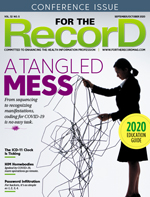September-October  2020
2020
By the Numbers
For The Record
Vol. 32 No. 5 P. 34
57
COVID-19 has caused a massive acceleration in the use of telehealth, with providers seeing 50 to 175 times the number of patients via telehealth than they did pre-COVID, according to McKinsey & Company. This percentage of providers now view telehealth more favorably and 64% are more comfortable using it. And while only 11% of US consumers used telehealth in 2019, now 46% use it and 76% are interested in using it moving forward.
$4.1 Billion
As of July 1, Forbes estimates Epic CEO Judy Faulkner's net worth at this amount.
1/2
This fraction of Americans believe artificial intelligence could help predict or prevent health epidemics (50%), identify personal health issues (57%), and develop better drugs or treatment plans (50%), according to a survey by Kantar, in partnership with the Digital Health Summit.
98
According to a study published in The Lancet Digital Health, an artificial intelligence program trained to recognize prostate cancer demonstrated this percentage sensitivity and 97% specificity at detecting the condition, which is significantly higher than previously reported for algorithms working from tissue slides.
16
Research by J. Marc Overhage, MD, PhD, and David McCallie Jr, MD, published in the Annals of Internal Medicine found that physicians spent an average of this many minutes and 14 seconds per encounter using EHRs, with chart review (33%), documentation (24%), and ordering (17%) functions accounting for most of the time.
40
Beth Israel Deaconess Medical Center researchers found that adding noninterruptive prompts into the emergency department EHR reduced unintentional duplicate orders for radiology tests by this percentage and for laboratory tests by 49%, according to a study by published in JAMA Network Open. Since it takes about nine clicks and 30 seconds to cancel an order, the prompts helped providers avoid making nearly 18,000 mouse clicks, saving about 16 hours and 36 minutes.
3
The West Virginia University Rockefeller Neuroscience Institute has created a digital platform that can detect COVID-19–related symptoms (eg, fevers, coughing, breathing difficulties, fatigue, and others) up to this number of days before they show up with over 90% accuracy.
4,347
Telehealth claim lines increased this percentage nationally from 0.17% of medical claim lines in March 2019 to 7.52% in March 2020, according to data from FAIR Health's Monthly Telehealth Regional Tracker, which indicates the growth was related to the COVID-19 pandemic.



